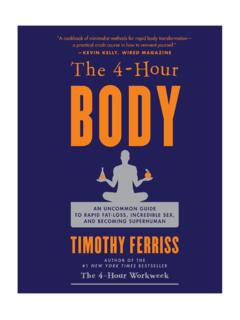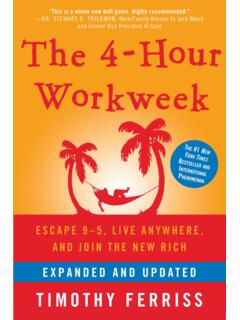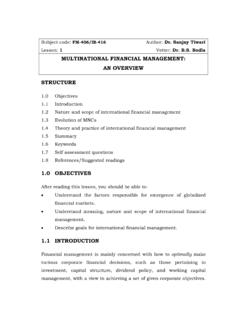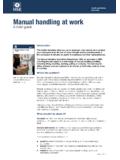Transcription of Testing The “Impossible” 17 QUESTIONS
1 TIM FERRISSTHAT CHANGED MY LIFEQUESTIONS1717 ABTesting The Impossible Reality is largely you stress-test the boundaries and experiment with the impossibles, you ll quickly discover that most limitations are a fragile collection of socially reinforced rules you can choose to break at any follows are 17 QUESTIONS that have dramatically changed my life. Each one is time stamped, as they entered the picture at precise moments. Whenever you find yourself on the side of the majority, it is time to pause and reflect. Mark Twain#1 What if I did the opposite for 48 hours?In 2000, I was selling mass data storage to CEOs and CTOs in my first job out of college. When I wasn t driving my mom s hand-me-down minivan to and from the office in San Jose, California, I was cold calling and cold emailing. Smiling and dialing was brutal.
2 For the first few months, I flailed and failed (it didn t help that my desk was wedged in a fire exit). Then one day I realized something: all of the sales guys made their sales calls between 9 and 5 Obvious, right? But that s part one. Part two: I realized that all of the gatekeepers who kept me from the decision makers CEOs and CTOs also worked from 9 to 5. What if I did the opposite of all the other sales guys, just for 48 hours? I decided to take a Thursday and Friday and make sales calls only from 7 to 8:30 and 6 to 7:30 For the rest of the day, I focused on cold emails. It worked like gangbusters. The big boss often picked up the phone directly, and I began doing more experiments with What if I did the opposite? : What if I only asked QUESTIONS instead of pitching? What if I studied technical material so I sounded like an engineer instead of a sales guy?
3 What if I ended my emails with I totally understand if you re too busy to reply, and thank you for reading this far, instead of the usual I look forward to your reply and speaking soon presumptuous BS? The experiments paid off. My last quarter in that job, I outsold the entire office of our biggest competitor, EMC.#2 SPORTSPOWER30%60 FuelPOWERBOOST750mgWhat do I spend a silly amount of money on? How might Iscratch my own itch?In late 2000 and early 2001, I saw the writing on the wall: the startup I worked for was going to implode. Rounds of layoffs had started and weren t going to end. I wasn t sure what to do, but I d been bitten by the startup bug and intoxicated by Silicon Valley. To explore business opportunities, I didn t do in-depth market research; I started with my credit card statement and asked myself, What do I spend a silly amount of money on?
4 Where did I spend a disproportionate amount of my income? Where was I price insensitive? The answer was sports supplements. At the time, I was making less than $40K a year and spending $500 or more per month on supplements. It was insane, but dozens of my male friends were equally overboard. I already knew which ads got me to buy, which stores and websites I used to purchase goods, which bulletin boards I frequented, and all the rest. Could I create a product that would scratch my own itch? What was I currently cobbling together (I had enough science background to be dangerous) that I couldn t conveniently find at retail? The result was a cognitive enhancer called BrainQUICKEN. Before everyone got fired, I begged my coworkers to each prepay for a bottle, which gave me enough money to hire chemists, a regulatory consultant, and do a tiny manufacturing run.
5 I was off to the races.#3 What would I do/have/be if I had $10 million? What s my realTMI?In 2004, I was doing better than ever financially, and BrainQUICKEN was distributed in perhaps a dozen countries. The problem? I was running on caffeine, working 15-hour days, and constantly on the verge of meltdown. My girlf riend, whom I expected to marry, left me due to the workaholism. Over the next six months of treading water and feeling trapped, I realized I had to restructure the business or shut it down it was literally killing me. This is when I began journaling on a few QUESTIONS , including What would I want to do, have, and be if I had $10 million in the bank? and What s my real target monthly income (TMI)? For the latter, in other words: How much does my dream life the stuff I m deferring for retirement really cost if I pay on a monthly basis?
6 (See ) After running the numbers, most of my fantasies were far more affordable than I d expected. Perhaps I didn t need to keep grinding and building? Perhaps I needed more time and mobility, not more income? This made me think that maybe, just maybe, I could afford to be happy and not just successful. I decided to take a long overseas QUESTIONS , also f rom 2004, are perhaps the most important of all, so they get their own chapter. (See fear-setting on page 463 in Tools of Titans. See also my TED talk on fear-setting: )#4 What are the worst things that could happen? Could I getback here?#5If I could only work 2 hours per week on my business, whatwould I do?After removing anxieties about the trip with fear-setting, the next practical step was removing myself as the bottleneck in my business. Alas, How can I not be a bottleneck in my own business?
7 Isn t a good question. After reading The E-Myth Revisited by Michael Gerber and The 80/20 Principle by Richard Koch, I decided that extreme QUESTIONS were the forcing function I needed. The question I found most helpful was, If I could only work two hours per week on my business, what would I do? Honestly speaking, it was more like, Yes, I know it s impossible, but if I had a gun to my head or contracted some horrible disease, and I had to limit work to two hours per week, what would I do to keep things afloat? The 80/20 principle, also known as Pareto s law, is the primary tool in this case. It dictates that 80% (or more) of your desired outcomes are the result of 20% (or less) of your activities and inputs. Here are two related QUESTIONS I personally used: What 20% of customers/products/regions are producing 80% of the profit?
8 What factors or shared characteristics might account for this? Many such QUESTIONS later, I began making changes: firing my highest-maintenance customers, putting more than 90% of my retail customers on autopilot with simple terms and standardized order processes, and deepening relationships (and increasing order sizes) with my three-to-five highest-profit, lowest-headache customers. That all led to ..#6 What if I let them make decisions up to $100? $500? $1,000?This question allowed me to take my customer service workload f rom 40-to-60 hours per week to less than 2 hours per week. Until mid-2004, I was the sole decision maker. For instance, if a professional athlete overseas needed our product overnighted with special customs forms, I would get an email or phone call from one of my fulfillment centers: How should we handle this?
9 What would you like to charge? These unusual edge cases might seem like rare exceptions, but they were a daily occurrence. Dozens per week hit me, on top of everything else. The fix: I sent an email to all of my direct reports along the lines of From this point forward, please don t contact me with QUESTIONS about A, B, or C. I trust you. If it involves less than $100, please make the decision yourself and take a note (the situation, how you handled it, what it cost) in one document, so we can review and adjust each week. Just focus on making our customers happy. I expected the worst, and guess what? Everything worked, minus a few expected hiccups here and there. I later increased the threshold to $500, then $1,000, and the reviews of decisions went f rom weekly to monthly to quarterly to once people were polished effectively never.
10 This experience underscored two things for me: 1) to get huge, good things done, you need to be okay with letting the small, bad things happen and 2) people s IQs seem to double as soon as you give them responsibility and indicate that you trust them.#7 What s the least crowded channel?Fast-forward to December 26, 2006. I had finished writing The 4-Hour Workweek and I had sat down after a lovely Christmas to think about the upcoming April launch. What to do? I had no idea, so I tracked down roughly a dozen best-selling authors. I asked each one QUESTIONS like, What were the biggest wastes of time and money for your last book launch? What would you never do again? What would you do more of? If you had to choose one place to focus $10,000, where would you focus? I heard one word repeatedly: blogs. They were apparently both very powerful and under-appreciated.








